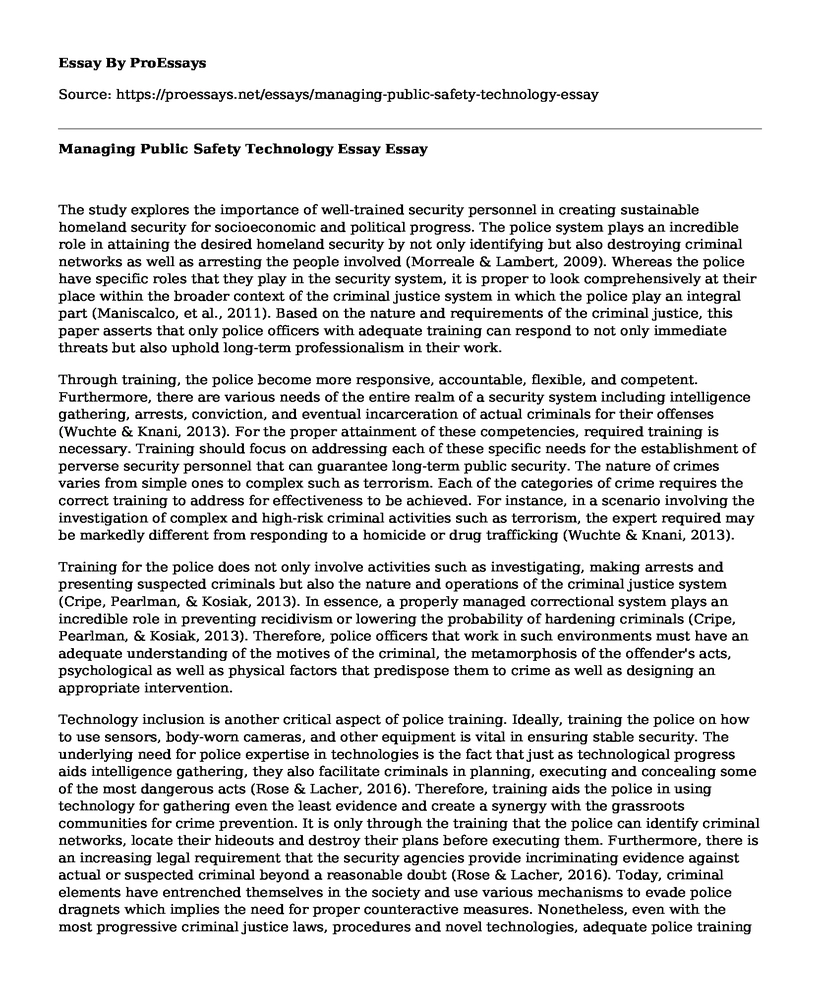The study explores the importance of well-trained security personnel in creating sustainable homeland security for socioeconomic and political progress. The police system plays an incredible role in attaining the desired homeland security by not only identifying but also destroying criminal networks as well as arresting the people involved (Morreale & Lambert, 2009). Whereas the police have specific roles that they play in the security system, it is proper to look comprehensively at their place within the broader context of the criminal justice system in which the police play an integral part (Maniscalco, et al., 2011). Based on the nature and requirements of the criminal justice, this paper asserts that only police officers with adequate training can respond to not only immediate threats but also uphold long-term professionalism in their work.
Through training, the police become more responsive, accountable, flexible, and competent. Furthermore, there are various needs of the entire realm of a security system including intelligence gathering, arrests, conviction, and eventual incarceration of actual criminals for their offenses (Wuchte & Knani, 2013). For the proper attainment of these competencies, required training is necessary. Training should focus on addressing each of these specific needs for the establishment of perverse security personnel that can guarantee long-term public security. The nature of crimes varies from simple ones to complex such as terrorism. Each of the categories of crime requires the correct training to address for effectiveness to be achieved. For instance, in a scenario involving the investigation of complex and high-risk criminal activities such as terrorism, the expert required may be markedly different from responding to a homicide or drug trafficking (Wuchte & Knani, 2013).
Training for the police does not only involve activities such as investigating, making arrests and presenting suspected criminals but also the nature and operations of the criminal justice system (Cripe, Pearlman, & Kosiak, 2013). In essence, a properly managed correctional system plays an incredible role in preventing recidivism or lowering the probability of hardening criminals (Cripe, Pearlman, & Kosiak, 2013). Therefore, police officers that work in such environments must have an adequate understanding of the motives of the criminal, the metamorphosis of the offender's acts, psychological as well as physical factors that predispose them to crime as well as designing an appropriate intervention.
Technology inclusion is another critical aspect of police training. Ideally, training the police on how to use sensors, body-worn cameras, and other equipment is vital in ensuring stable security. The underlying need for police expertise in technologies is the fact that just as technological progress aids intelligence gathering, they also facilitate criminals in planning, executing and concealing some of the most dangerous acts (Rose & Lacher, 2016). Therefore, training aids the police in using technology for gathering even the least evidence and create a synergy with the grassroots communities for crime prevention. It is only through the training that the police can identify criminal networks, locate their hideouts and destroy their plans before executing them. Furthermore, there is an increasing legal requirement that the security agencies provide incriminating evidence against actual or suspected criminal beyond a reasonable doubt (Rose & Lacher, 2016). Today, criminal elements have entrenched themselves in the society and use various mechanisms to evade police dragnets which implies the need for proper counteractive measures. Nonetheless, even with the most progressive criminal justice laws, procedures and novel technologies, adequate police training is the only way of attaining sustainable homeland security. The underlying premise of this proposition is the fact that systems and laws operate, the human resource must intervene to achieve the desired outcomes.
References
Cripe, C. A., Pearlman, M. G., & Kosiak, D. (2013). Legal aspects of corrections management. Burlington, MA: Jones & Bartlett Learning.
Maniscalco, P. M., Christen, H. T., STAT!Ref (Online service), & Teton Data Systems (Firm). (2011). Homeland security: Principles and practice of terrorism response. Sudbury, Mass: Jones and Bartlett Publishers.
Morreale, S. A., & Lambert, D. E. (2009). Homeland security and the police mission. Journal of Homeland Security and Emergency Management, 6(1).
Rose, J. A., & Lacher, D. C. (2016). Managing Public Safety Technology: Deploying Systems in Police, Courts, Corrections, and Fire Organizations. Taylor & Francis.
Wuchte, T., & Knani, M. (2013). Countering violent extremism and radicalization that lead to terrorism: the OSCE's unique regional blueprint. Journal Exit-Deutschland. Zeitschrift fur Deradikalisierung und demokratische Kultur, 2, 76-85.
Cite this page
Managing Public Safety Technology Essay. (2022, May 09). Retrieved from https://proessays.net/essays/managing-public-safety-technology-essay
If you are the original author of this essay and no longer wish to have it published on the ProEssays website, please click below to request its removal:
- A Discussion on Homophobia and Its Impact on Gender Equality Essay
- Cocaine: Drug-Taking Behavior Paper Example
- Article Analysis Essay on Self-Driving Cars: Is It Reckless to Delay
- High School Student Behaviors: Drug Usage, Theft, and School Security - Essay Sample
- Drug Abuse: Taking Medications for Non-Therapeutic Reasons - Essay Sample
- Gender Issues in Postcolonial Literature: A Comparative Analysis - Essay Sample
- Essay Example on Racial War in US: The Three Documentaries Showing KKK and Black Liberation Movements







